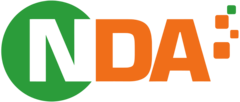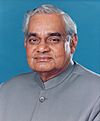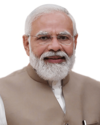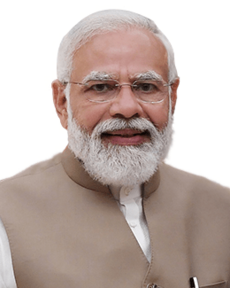National Democratic Alliance facts for kids
Quick facts for kids
National Democratic Alliance
Rāṣṭrīya Lokatāntrik Gaṭhabandhan
|
|
|---|---|
 |
|
| Abbreviation | NDA |
| Chairperson | Amit Shah (Union Minister of Home Affairs) |
| Lok Sabha leader | Narendra Modi (Prime Minister) |
| Rajya Sabha leader | J. P. Nadda |
| Founder | |
| Founded | 15 May 1998 |
| Ideology |
|
| Political position |
|
| Alliance | 39 parties |
| Seats in Lok Sabha |
293 / 543
|
| Seats in Rajya Sabha |
133 / 245
|
| Seats in State Legislative Assemblies |
2,315 / 4,126
|
| Seats in State Legislative Councils |
181 / 423
|
| Number of states and union territories in government |
20 / 31
|
The National Democratic Alliance (NDA) is a large group of Indian political parties that work together. Think of it as a team of different parties who have joined forces. The team is led by India's largest political party, the Bharatiya Janata Party (BJP). The NDA was formed on May 15, 1998.
Currently, the NDA holds the majority of seats in both houses of the Indian Parliament, the Lok Sabha and the Rajya Sabha. This means they control the main Government of India. They also lead the governments in 19 out of 28 states and 2 out of 3 union territories that have their own legislatures.
The first chairman of the NDA was Atal Bihari Vajpayee, who was also the Prime Minister of India at the time. Later, L. K. Advani served as chairman from 2004 to 2014. Since 2014, Amit Shah has been the chairman.
The NDA was in power from 1998 to 2004. It returned to power after winning the 2014 general election. Its leader, Narendra Modi, became the Prime Minister of India on May 26, 2014. In the 2019 election, the alliance won even more seats. In the 2024 election, the NDA won enough seats to form the government again, this time as a coalition government, where multiple parties share power. This was Narendra Modi's third term as Prime Minister.
Contents
History of the NDA
The National Democratic Alliance was created in May 1998. Its main goal was to form a team of parties to challenge the Indian National Congress, which was a very powerful party at the time. The NDA was led by the BJP and included many smaller, regional parties.
Early Years and First Government
After the 1998 election, the NDA managed to get just enough support to form a government. Atal Bihari Vajpayee became the prime minister. However, this government did not last long. One of the main parties, the AIADMK, withdrew its support, and the government fell after about a year.
The NDA, now with a few more parties on its team, won the next election in 1999 with a bigger majority. Vajpayee became prime minister for the third time and completed a full five-year term.
A Period in Opposition
In the 2004 election, the NDA lost power to the United Progressive Alliance (UPA), which was led by the Congress party. The NDA was the main opposition party for the next ten years. Many people believe the NDA lost because it didn't focus enough on the needs of people living in rural areas.
Return to Power with Narendra Modi
The situation changed when Narendra Modi, who was the Chief Minister of Gujarat, became a prominent leader in the BJP. He led the NDA in the 2014 election, and the alliance won a huge victory. Narendra Modi became the Prime Minister.
The NDA won again in the 2019 election, increasing its number of seats. In the 2024 election, the NDA won enough seats to form the government for a third time in a row, with Modi continuing as Prime Minister. This time, however, the BJP did not win a majority on its own, making the support of its allies like the Telugu Desam Party and Janata Dal (United) very important.
How the NDA is Structured
The NDA is not like a single company with a board of directors. Instead, it's a group of different parties. The leaders of each party in the alliance meet to make important decisions. They decide things like how to share seats in elections and who gets to be a minister in the government.
Because the parties have different ideas, they sometimes disagree on issues. The leader of the alliance, called a convener, helps everyone work together. Over the years, leaders like George Fernandes, Sharad Yadav, and N. Chandrababu Naidu have served as the NDA's convener.
Chairmen of the NDA
- Atal Bihari Vajpayee (1998–2004)
- L. K. Advani (2004–2014)
- Amit Shah (2014–present)
Famous Leaders from the NDA
The NDA has had several important leaders who have served the country in top positions.
Prime Ministers
The NDA has given India two Prime Ministers.
| Name | Portrait | Term in Office | Party |
|---|---|---|---|
| Atal Bihari Vajpayee |  |
1998–2004 | Bharatiya Janata Party |
| Narendra Modi |  |
2014–present | Bharatiya Janata Party |
Presidents of India
The President of India is the head of state. The NDA has nominated three people who went on to become President.
- A. P. J. Abdul Kalam (2002–2007): A famous scientist known as the "People's President."
- Ram Nath Kovind (2017–2022): He was the Governor of Bihar before becoming president.
- Droupadi Murmu (2022–present): She is the first person from a tribal community to become President of India.
Images for kids
See also
 In Spanish: Alianza Democrática Nacional (India) para niños
In Spanish: Alianza Democrática Nacional (India) para niños
- North-East Democratic Alliance
- United Progressive Alliance
- Indian National Developmental Inclusive Alliance





